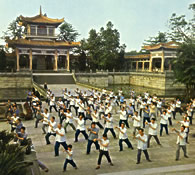|
Tai-Ji is a Traditional Chinese Art practised for mental, physical, and spiritual discipline for cultivating the internal energy system. Tai-Ji is unique among the ‘Three Sisters’ [Xing Yi, Bagua Zhang, and Tai-Ji] in having the greatest affinity to Wuji – the first, most ancient of the Chinese Internal Arts (of which the ‘Three Sisters’ are the most well-known, dating as they do from more recent times) – in that both Tai-Ji and Wuji, in addition to their renowned fighting application, also provide very great benefits to physical, mental, and ultimately, spiritual well-being. Tai-Ji applies the concept of yin yang interplay to fighting: meeting force (yang) not with force, but with softness (yin) which through sticking and adhering to the opposing force comes to absorb and weaken it, until it can be easily redirected or beaten with minimal effort.
Tai-Ji Quan’s creation is attributed to the legendary figure of the late Song Dynasty Daoist Zhang San Feng, but it is certain that the art was being practiced in elementary form long before his day – just as the older, and partly related, lesser well known art of the Wuji similarly has origins still more ancient.
However, the founder of the first form of Tai-Ji in definitive form was Chen Wang Ting (1600-1680 CE). Chen Style Tai-Ji is the oldest of the five major styles of Tai-Ji: Yang Style being the most popular and well-known of the five.
FOR MORE AND FULLER DETAILS OF THE THERAPEUTIC DIMENSION OF TAI-JI PLEASE VISIT THE MEDICAL AND THERAPEUTIC PAGE OF www.qi-china.com
|
